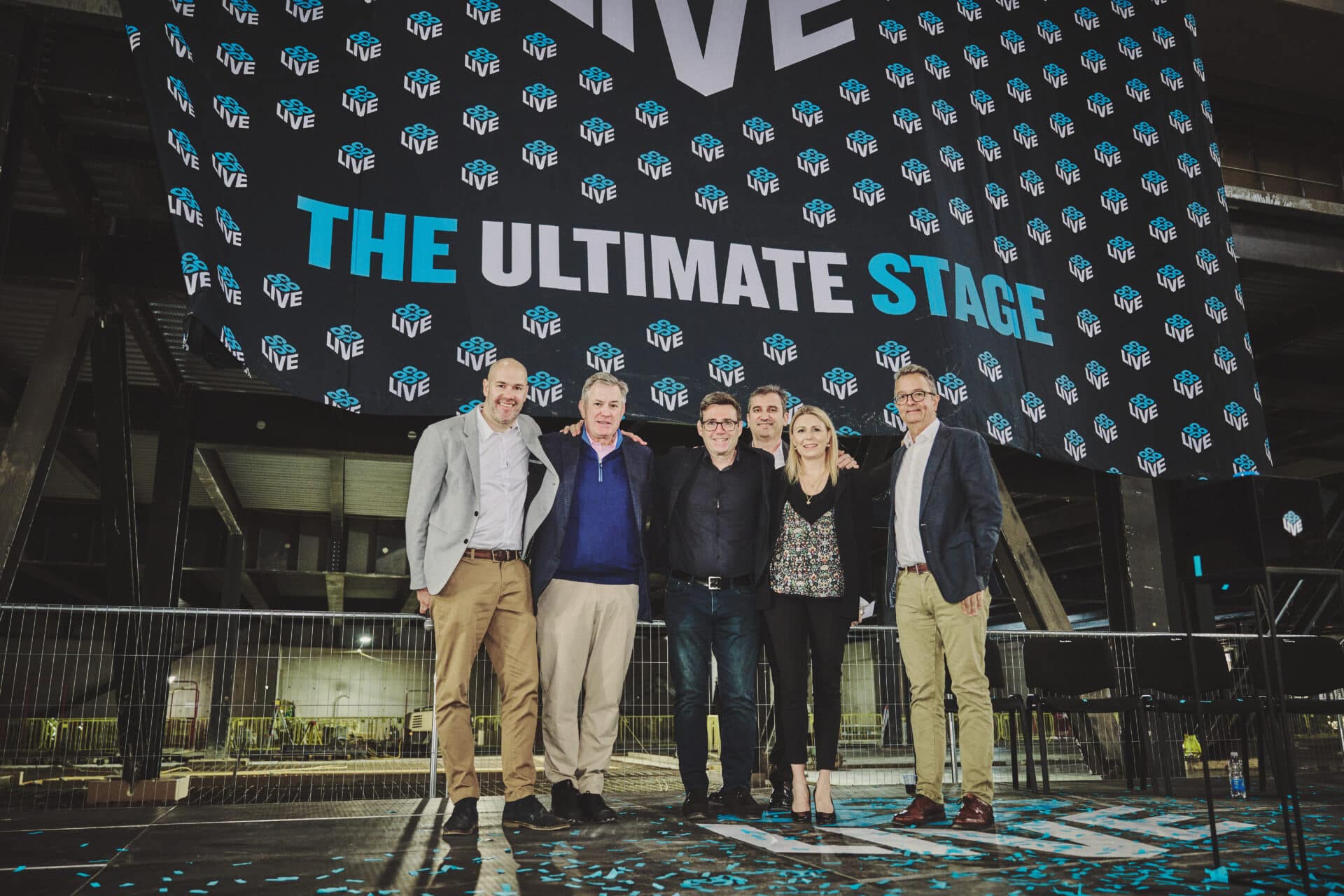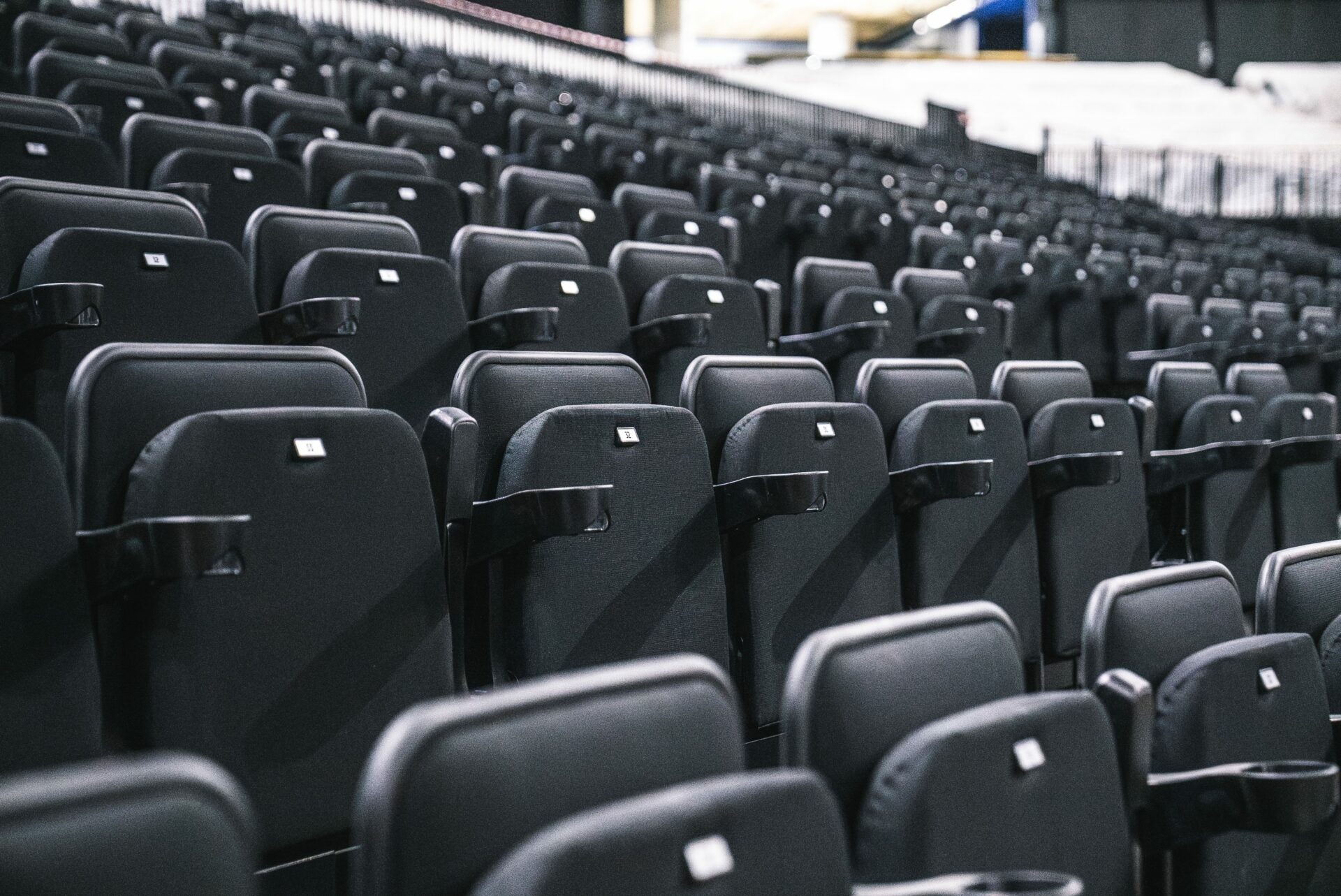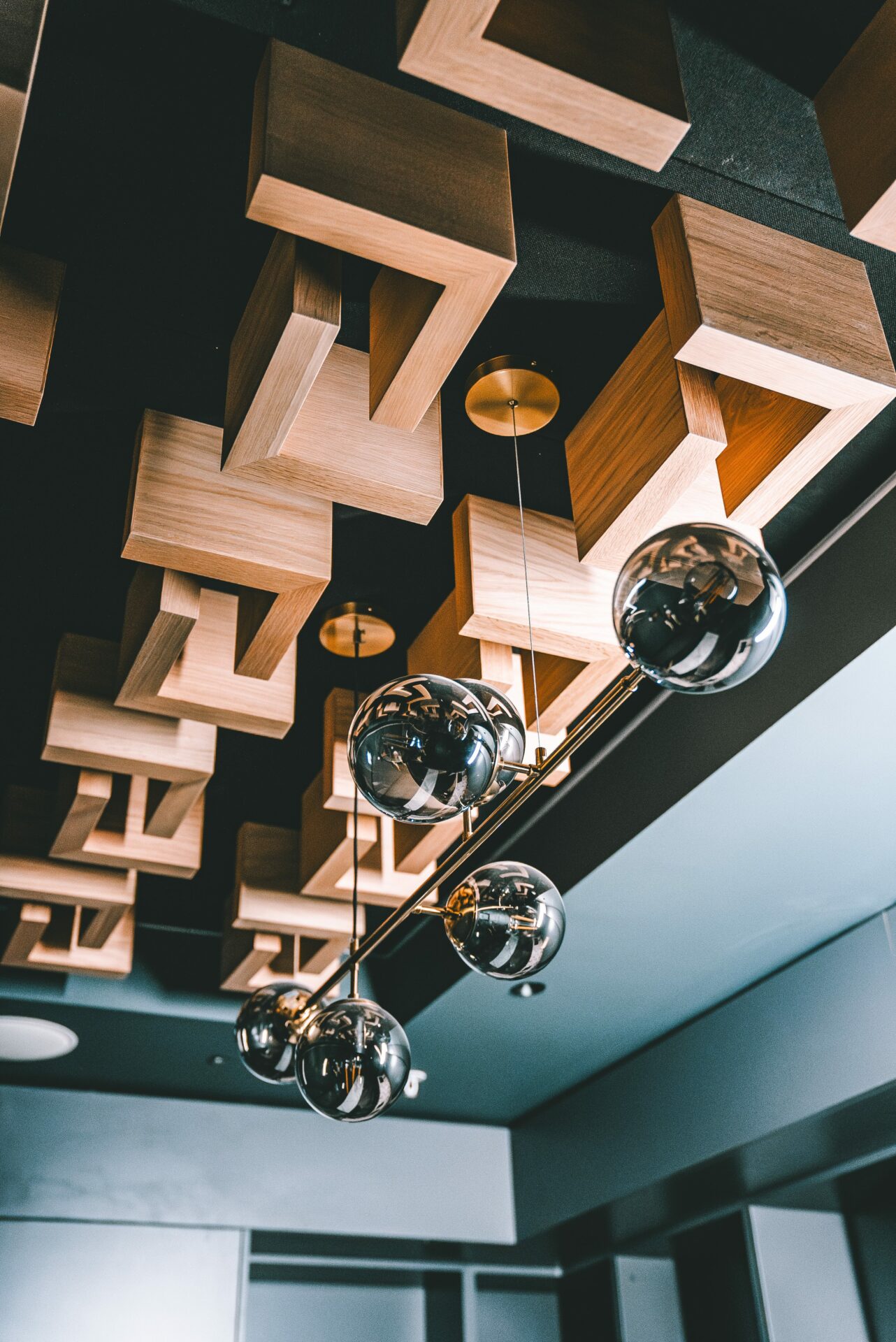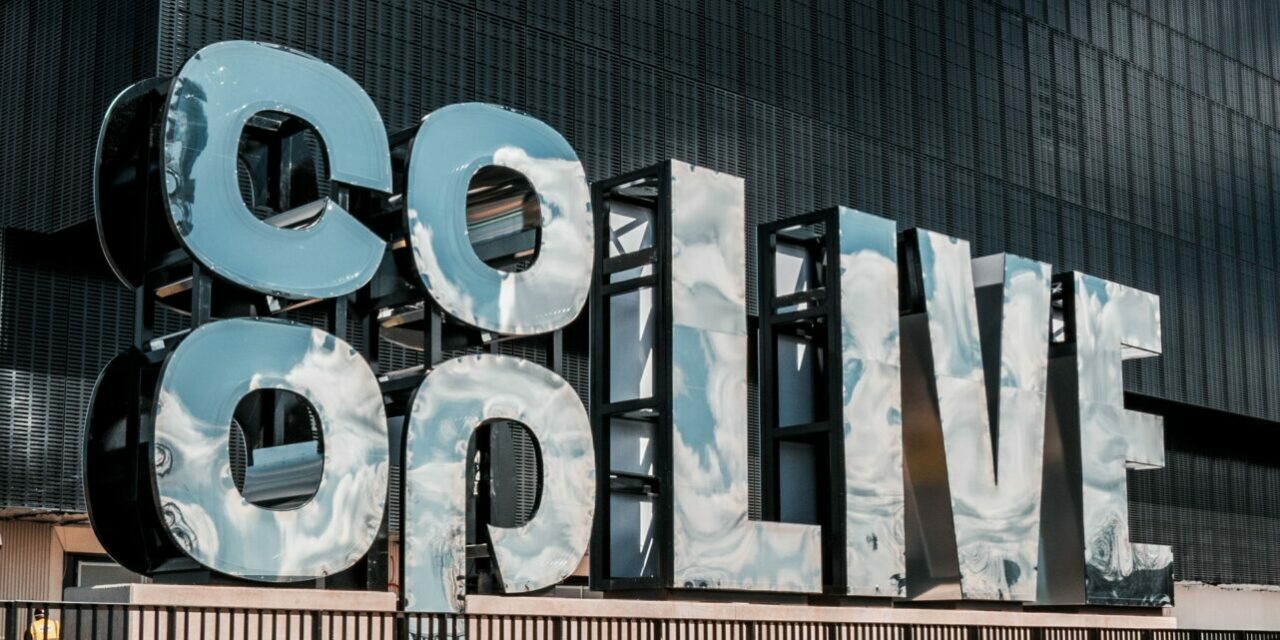SHOWTIME: Co-op Live remained under construction in early April, readying for its April 23 opening concert with Peter Kay. (Photo courtesy OVG)
The trends tied to developing new multipurpose arenas are increasingly focused on the live entertainment component apart from sports.
Now, an arena has been built with music at the heart of all considerations: Co-op Live in Manchester, England. It’s Oak View Group’s first arena project outside of the United States, and at a project cost of $460 million, it’s the most expensive arena built in Europe. The numbers and stats around this building are eclipsed by the promise it holds for both artists and fans. (Oak View Group is parent company to VenuesNow).
A capacity of 23,500; the biggest standing arena floor in the UK at 9,000 to 10,000 capacity; a bowl design that creates an intimacy between artists and fans despite the vastness of the building — a lot of that is a result of not having a sports tenant; a laser-focus on sustainability and the fan experience in general; and sound design without equal in the UK or Europe. Conceived by OVG chairman and CEO Tim Leiweke, designed by Populous and built by British construction firm BAM, and brought to life with the help of co-investors City Football Group, Harry Styles, and some of the UK’s finest promoters including Simon Moran and Denis Desmond, plus an innovative naming rights sponsor in Co-op, sold by the team at OVG International.
See Also:
Q&A With OVG CEO Tim Leiweke
Q&A With Stephen Collins
A Look At Co-op Live’s Acoustics Treatment
Co-op Live is projected to host more than 120 events in its first year, mostly music, with something for everyone: from Olivia Rodrigo, and Nicki Minaj, who’ll each perform two nights, to The Killers and Liam Gallagher, who will both perform four nights, to five nights with the Eagles, who’ll be giving their only UK farewell concerts in Manchester this year, to seven nights with Manchester’s own Take That.
The program is attracting guests from all over the country, says Co-op Live’s general manager and executive director, Gary Roden.
“We are pulling from all around the UK, and that’s because people have bought into the vision of the venue,” Roden said. “The programming is dictating that. You no longer have to go to London to see those big acts, because they now come to London and Manchester. I’m here to deliver the very best program for Manchester, that benefits the fans that live locally and people in those surrounding areas in the north of England, who don’t want to travel to London. There’s now a space for them to come and see it in the very best facility possible.”
Ticketmaster managing director Andrew Parsons confirms, “There’s a buzz with a new venue, especially when it’s selling out. The team’s energy, enthusiasm and passion as events go on sale, and subsequently sell out, is contagious.” What’s impressive, he adds, “is the venue’s reach and the lengths fans are going to catch these gigs — 30% are traveling over (60 miles). Co-op Live is turning into a powerhouse for live entertainment, not just up north, but internationally too. The place is already on the tour map, and it’s not even open yet.”
Gary Hutchinson, vice president, booking and commercial partnerships for OVG International, adds, “Traditionally London has always had more play dates than Manchester, but our aim with Co-op Live is to transform Manchester’s entertainment scene, bringing more shows to the city and making it one of the world’s top entertainment markets again. That is evident in the current run of dates. We are seeing people from the south of the UK set to travel up to Manchester, as well as from Europe, which is a great indication of our global appeal.”

THE A-TEAM: (L-R) OVG’s Gary Roden, Tim Leiweke, Greater Manchester Mayor Andy Burnham, City Football Group’s Ferran Soriano, Co-operative Group’s Amanda Jennings and BAM’s James Wimpenny.
Leiweke had known about the potential of Manchester, about 200 miles northwest of London, as a live entertainment destination since building The O2 in London during his time at AEG. The O2, which opened in 2007, quickly became the country’s busiest building. Manchester’s existing arena, AO Arena, opened in 1995, was never far behind in ticket sales.
“That spoke about what a great music market Manchester is, its culture and history, the artists that have come from there – it’s an amazing market,” Leiweke said.
Years later, when Leiweke founded OVG with music industry titan Irving Azoff in 2015, “We knew, (Manchester) was going to be a high priority for our company,” Leiweke said. “We also made a bet that we would build an arena that would ultimately be the most expensive, most sophisticated, most advanced, and most revolutionary arena built internationally.”
“There’s no comp to it,” says Stephen Collins, OVG’s president of global venue development and special projects (see page 26). It’s unusual in terms of the elements that we’re trying to accomplish, whether it’s rigging or loading or acoustics. I’m an operations guy, I have been doing this for 30 years, so I get geeked out on what it’s like for the tour. But from a production perspective: How does the artist and the tour respond to the building? We spent a lot of time on the rigging system. How do you hang 250,000 pounds and make it easy for people that have never even rigged before? You can basically get to any of the rigging points in the building without having to hop over the rail. Same thing with truck loading and marshaling area, dressing rooms, green room, crew catering — the ability to go from a 10,000-capacity floor to a more intimate in-the-round with retractable seating. It’s phenomenal.”
Touching on the back-of-house amenities, lead architect on the project, Declan Sharkey, senior principal and director at Populous, serving Europe, the Middle East and Africa, says, “There are 12 artist changing rooms that are going to deliver an experience and level of finish that doesn’t exist anywhere in Europe. It’s incredibly flexible — artists can bring in their own chef, they can personalize the space, bring in their own equipment. The loading bay is incredibly flexible, as well, very large. We can unload eight trucks in parallel.”
The development team took inspiration from OVG’s arena projects in the U.S: Climate Pledge Arena in Seattle, Moody Center in Austin, and UBS Arena in New York.
“At one point we decided to get the whole design team to the U.S., and go visit five to six buildings, each one of them having individual elements that worked well. We thought about which ones we’d like to bring back over, which ones would fit in this market,” Collins recalls.
Still, while individual elements could offer inspiration, most of the things you see at Co-op Live have never been done before.

HAVE A SEAT: The seating at Co-op Live, standard (shown here) and VIP, was provided by Audience Systems. This photo shows their Espace model upholstered in a 100% post-consumer recycled fabric. Nina Parmenter of Audience Systems said, “OVG wanted to go with a high specification chair from the start, so even the standard model will be really comfortable.”
“One of the things that will be unparalleled, probably even in the U.S., is the acoustics of the building,” says Collins. “Yes, we can do basketball, UFC and other sports, but the acoustical treatments in the building are directed squarely at music. All of the exposed surfaces have some kind of acoustical treatment. It surpasses anything we’ve done before.”
Because there’s no sports tenant, there’s no need for an ice rink, enabling the designers at Populous to bring the seating tiers 72 feet closer to the stage. Sharkey, the lead architect, said, “When you put in an ice pad, you have a dasher board. The fans need to be able to see over that, so the sight lines start to push the bowl back a little bit. The moment we don’t need that permanent ice pad, we’re able to bring everyone close and make it much more intimate.”
There was also no need for a giant center-hung video board hanging from the ceiling. As a result, the overall arena height was brought down as well, retaining the (same 78-foot height) that will accommodate international touring shows, adding to the intimate feel.
Promoter Matt Woolliscroft of SJM, said, “My visit (to Co-op Live) was at the end of last year when the building was very much still a building site, and there were no seats in place in the upper tier. My overriding feel for the space was that it felt very intimate for the capacity.”
Roden said, “Every single promoter, anyone that’s really experienced in the industry, that we’ve taken to the back of (the upper deck), couldn’t believe they were in the cheap seats, because it still feels that close.” Couple that with the biggest arena floor in the UK.
“You sit at the back (of the arena) and you feel like you’re too close, but then you stand on the floor, and it’s so vast that it feels like you’re at a stadium gig, only the sound’s 10 times better, because it doesn’t disappear anywhere,” Roden said. “Hopefully, those two dynamics coming together are going to create a new experience.”
The building contains 28 private suites, most with a capacity for 16 guests, as well as two with a capacity for 24. There are four Gallery Suites, similar to loge boxes, two at a 127 capacity, and two at 54. The AMP Club offers space for 656, the Bentley Record Room has space for 100, and the Decibel Club can host 200. Memberships were mostly sold out at press time, with some left for the AMP Club and Decibel Club. Becci Thomson, head of premium sales at Co-op Live, said, “We don’t see the fact we don’t have a sporting tenant as a negative, as our premium clients get access to 120-plus top-tier music and sporting events, which gives a huge variety of events throughout the year. Our membership and suites are sold on an average term of five years and over half of our private suites are sold on 7-10 year contracts.”
Another new experience is Co-op Live’s clean seating bowl. Having no sports tenant meant being able to eliminate digital advertising in the seating bowl. Instead, sponsors’ brands are displayed on LED screens on concourses and premium spaces. In addition, there’s an external halo LED screen on the arena exterior.

FINISHING TOUCHES: OVG chairman and CEO Tim Leiweke says the finishes inside Co-op Live are some of the finest he’s seen.
“This is a moment for you and the artists, and there’s no distractions, no other stimulation outside of that connection,” Roden said. “That’s based on the feedback we’ve received from artists like (Co-op Live investor) Harry Styles and others about what we could do to make that connection between the artists and the fan as great as possible. You can sell advertising in a bowl, but that’s how dedicated we are to making sure we deliver on what we’ve talked about.”
A key piece of Leiweke’s vision was to make Co-op Live the most sustainable arena built internationally, running on 100% electricity, with innovative food and rainwater recycling programs in place.
“By the time we get the (solar photovoltaic) PV panels up, we’ll get to net zero carbon,” says Collins, before explaining how the arena is heated and cooled. “Instead of pushing all the heat from the bowl outside when we have a show, it’s recovered as it leaves the air handling units, into water coils, which then feed units that heat the domestic hot water. So, instead of just dumping that heat outside of the building, we’re pulling it out of the air before we discharge. From a sustainability perspective, it’s important to the city, and it’s important to us as a company.”
Food service, aided by Rhubarb, OVG’s in-house premium catering business, features 41 bars, restaurants and markets, ranging from grab and go to sit-down VIP options.
“A lot of arenas will shoot from the hip on the food and beverage side, until they get an operator on board, and then the operator’s got to live with what they’re inheriting, because decisions had to be made early on,” Collins said. “We’ve taken a lot of this stuff in-house now, and placed a big emphasis on it from the beginning. It was one of the things that we got a lot of pushback for initially: ‘People aren’t going to change their eating habits,’ or, ‘There’s not a high expectation for culinary and food.’ People will be blown away by the different food and beverage offerings, the bars, the tapped beer. Over here, draft beer is everything, and the draft beer system distributed around the building is remarkable.”
The spirit and commitment of those involved in bringing the project to life can’t be discounted, Leiweke said. From co-investors City Football Group and Harry Styles, to Manchester Mayor Andy Burnham and head of the city council Bev Craig, to the architects at Populous, tasked with reinventing the industry and the OVG International team.
“BAM had the biggest bumps in the road within this process, yet, they persevered,” Leiweke said. “The quality craftsmanship of the finishes in this building are some of the finest I’ve seen in my career. We overcame COVID, Brexit, and the fact that it’s harder to get the trade and the craftsmen that we need. Somehow, BAM got through all of that, and they’re going to get us to the finish line, and I’m extremely grateful and proud of them.”







